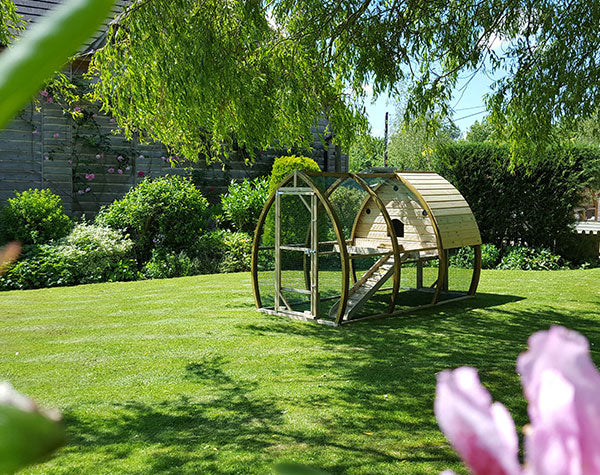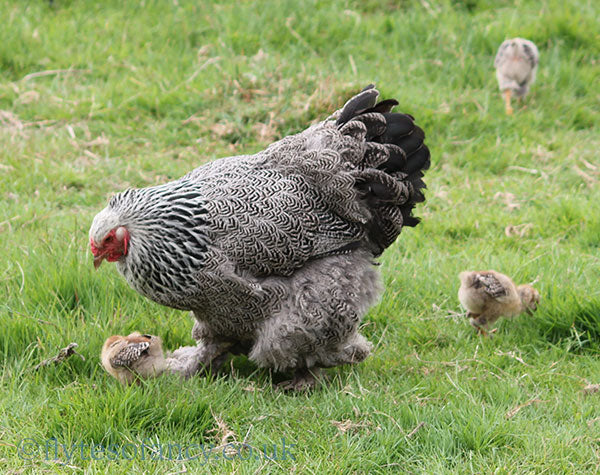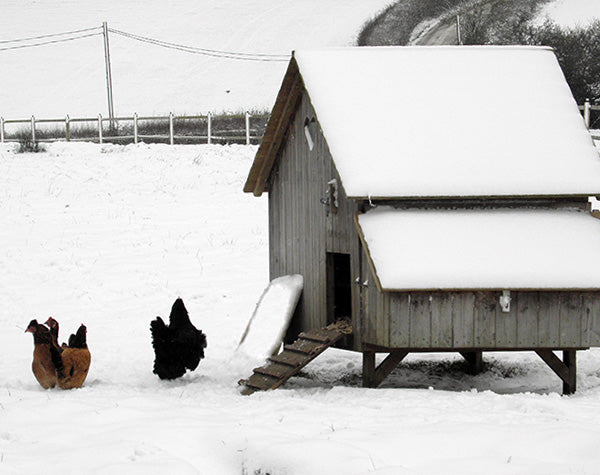What is the ideal Rabbit Enclosure?
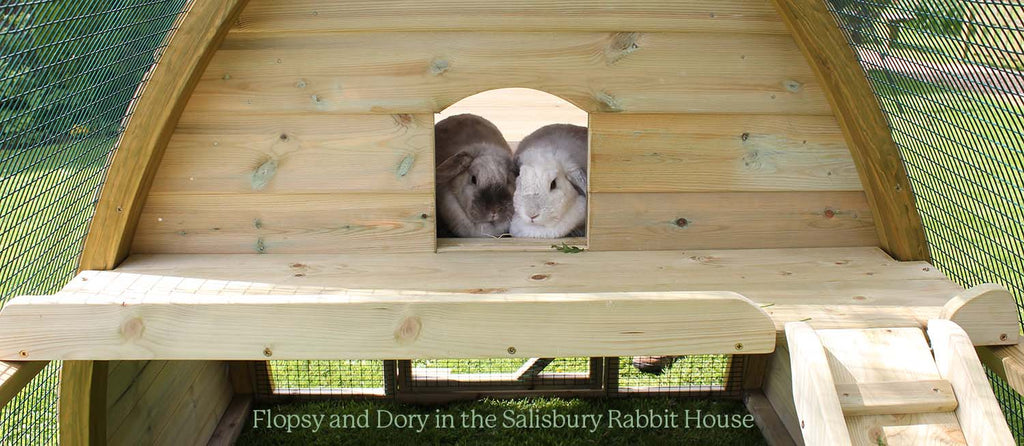
History of the Hutch (what not to keep rabbits in!)
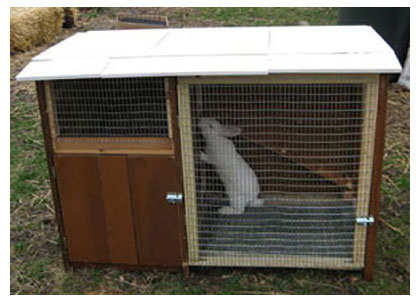
Thankfully, gone are the days when pet rabbits were housed in converted sideboards ... or are they?
We can find quite a few proud chaps showing off their 'conversions' on websites and blogs today, like this image here.
Poor, poor bunny ... Sideboards were, of course, made by craftsmen in the olden days, and it's fair to say they looked lovely - as sideboards. What about the poor rabbits though, are they happy?
Making use of an old sideboard was very popular, it seems and that the most obvious use for one was housing the pet rabbit. By removing a door, being careful to retain one of the doors for access to the sleeping compartment, and then using anything you could find, such as old mesh and string to hold it all together, the poor rabbit was confined to this untidy creation.
Over the decades, I'd like to think we have progressed a little from the rickety old sideboard, but the most common pet rabbit hutch in pet shops today is usually mass-produced in the far east. Most typically a box shape, looking like a sideboard, and cheap. These are cramped and cold as well as poor in size and quality.
Rabbit hutch designs have not changed very much over the years, and today's options include - A rectangular box-shaped hutch with mesh front and sleeping quarters, or perhaps a rectangular box with mesh front and sleeping quarters and legs.
Breeding Hutches are slightly different, though. They are rectangular boxes with mesh fronts and sleeping quarters, and luckily still have the added option of legs. However, each Hutch has been stacked one on top of the other. Sometimes these houses are simply wired cages with wire mesh floors for the bunnies to stand on - horrid!
It seems a little unfair to deny the rabbits any pleasure of passing the time of day with their 'flat mates' who reside on the upper and lower floors (although we understand for breeders this is not always an option). Don't you think they would love to wander around on the grass in the lovely fresh air?
The old 'stack 'em high - breed 'em cheap' is, in our opinion, not the kindest option. As you've probably gathered, we felt the need to design Hutches with a difference to put bunny welfare first.
Our sheer dislike of the normal outdoor rabbit hutch style gave us the impetus to develop our Arched Rabbit Houses. Combining attractive contemporary looks and perfect practicality, we also offer superb build quality and thick timbers to keep them warm, safe, and dry. More importantly, the run space for the rabbit to develop both mentally and physically.
The Arched Rabbit House
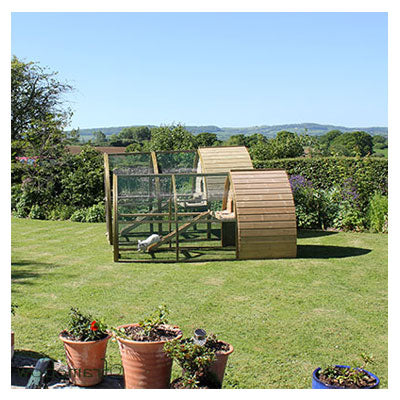
This Arched Rabbit House is a large Rabbit House with spacious accommodation, a sundeck and a long ramp leading to the lovely grass below. Suitable for two bunnies.
It is over 9ft long by almost 5ft wide and 6ft high - 49 sq ft (with options to add extensions to the run). Inside, the house floor is 13 sq ft plus the 12in x 5ft wide Sundeck. Total accessible area 65 sq ft (6 sq m). Adding an extension run will increase the run at ground level by approx. 12 sq ft.
Your Rabbits exit the house directly onto the sundeck. Around the edge of the sundeck and the ramp, we have added raised edges to prevent those 'I wish I'd brought a parachute' moments.
The raised house makes maximum use of the space underneath and makes cleaning and tending much easier. This space provides an area for shelter or shade and, with a height under the house of 76cm (2ft 6in), also gives bunnies room to stand on their hind legs.
The Walk-in Run has an internal height of 173cm (5ft 8in), so very accessible for most of us and will allow children the space to sit inside with their bunnies.
We don't advise or advocate putting a mesh base in the rabbit's outdoor run as it would be very uncomfortable for the bunnies.
Unlike cats and dogs, rabbits do not have padded paws to cushion them. Their paws have claws but are just covered in fur, so a mesh floor could damage or disfigure their feet and be extremely uncomfortable.
If you don't have options to move the hutch to fresh ground regularly and wish to prevent them from digging, place a cushioning layer like woodchip on top of the mesh.
The Salisbury Rabbit or Guinea Pig House

The Salisbury Rabbit House design, based on our larger Arch Rabbit House, is proving very popular due to its compact nature and ease of cleaning.
We think our advances in designing hutches, offering luxury living for your rabbits or pets, is streets ahead of what is available on the market today. And, being made of eco-pressure-treated timber, it will certainly last and look good for many years. Visit our Sustainable Timber page to read about Eco-Pressure Treated Wood.
Suitable for one or two small rabbits, the Salisbury House has a run area of approx 39 sq ft with options to extend the run. An extension section will add a further 12 sq ft to the run. The house floor itself is approx. 10 sq ft.
It is very easy to clean and includes a sleeping tray as well as a drinker bottle stand for inside the house.
More information about the timbers we use for our houses can be found on the About our Housing page or follow this link specifically for Arched Timber Houses.
- - -
5 Top Tips for Happy Bunnies
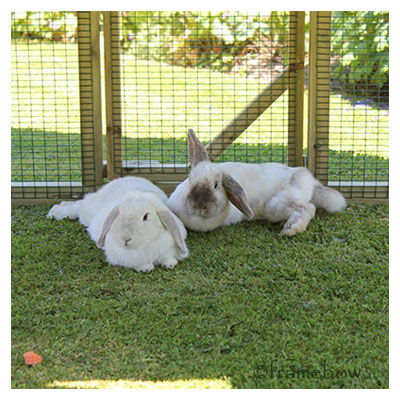
This is what we like to see isn't it ... two relaxed, happy bunnies snoozing in the shade of their Arch Rabbit House on a lovely summer’s day.
- Allow plenty of nice soft bedding in the house, like Chopped Hemp Bedding, Hay or Straw. Do not use newspaper or pine shavings (they can be harmful if they ingest them). In cold weather, fill their house with lots of extra bedding for them to snuggle into so they can stay warm. Keep the Hutch clean and healthy by changing bedding every few days and doing a proper clean once a week.
- Be good about their diet. Plenty of hay for their digestion and a good quality pelleted rabbit feed. Leafy greens are a nice regular treat, and root vegetables as an occasional treat. Don't feed them muesli type feed or grass cuttings (it upsets their digestion).
- Allow plenty of exercise. If they are in an outdoor run, provide as much space for running around as possible with stimulation like ramps to run up and down or cardboard boxes to play in (be careful they don't eat them though). Encourage exercise by playing with them.
- Ensure your outdoor run is predator-proof. Foxes can easily dig into a run underneath the edges, as can Rats, so always make sure the run is a small-size mesh and surrounded with an Anti-Dig Mesh. Heavy-duty metal weldmesh is best and regularly check for gaps that may allow predators intrusion.
- Regularly handle your bunny and check its health, particularly its front gnawing teeth which can grow at up to 3mm a week. Be prepared to take it to a vet if you notice any change in its behaviour, especially lack of eating. Rabbits are good at hiding pain.
- - - -
All About Rabbit Hutches is ©Framebow (Flyte so Fancy) 2015. Updated 2021. Author: Anne Weymouth (Director, Flyte so Fancy Ltd). Reproduction of part or all of this text is only possible with the express permission of Flyte so Fancy Ltd.

